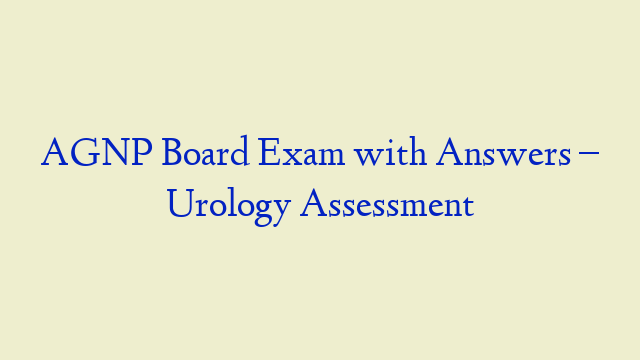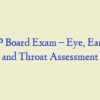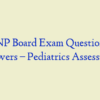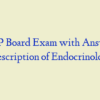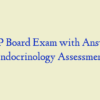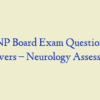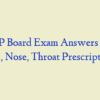Description
AGNP BOARD EXAM QUESTIONS Urology Assessment (44 Questions)
- In renal adaptation of the newborn, which one of the following statements is correct?
- What is the most common non-skin cancer in America?
- Patients with prior hypospadias surgery who develop slow and painful urination as well as prostatitis are experiencing symptoms of:
- What is the average urine pH level?
- Symptoms of proctitis may include all of the following except:
- A useful mnemonic for elucidating causes of incontinence in the older adult is:
- Which of the following symptoms is NOT associated with nephrotic syndrome?
- In afebrile patients who experience intermittent sharp flank pain in addition to gross hematuria, further testing would be indicated for:
- After running a 5K race, a 35-year-old man presents with complaints of muscle pain in the shoulders, weakness in both legs, and dark brown urine. These findings are consistent with:
- When testing for pyelonephritis, the exam technique of percussing the back over the kidney that produces flank pain is called:
- A form of urinary incontinence that is characterized by the involuntary release of urine from a full bladder in the absence of any need to urinate is called:
- One cause of proctitis could be related to:
- An infection or irritation of the bladder that leads to pain on urination is called:
- Symptoms of fever, chills, flank pain, costovertebral angle tenderness (CVA), and vomiting suggest:
- Which of the following substances is found in the urine of a child suspected of having post-streptococcal glomerulonephritis?
- A significant increase in 24-hour urine volume that exceeds 3 liters is called:
- The findings of mucopurulent endocervical discharge and cervical motion tenderness on pelvic examination are strongly suggestive of:
- In men, painful urination without frequency or urgency suggests:
- Which one of the following is NOT a cause of vaginitis?
- Which one of the following conditions is NOT related to polyuria?
- The prostate is assessed by:
- Which one of the following patient positions would be least beneficial to examine the genitals of a young female child?
- Benign prostatic hypertrophy begins in the:
- Patients with multiple sclerosis (MS) who develop urinary incontinence are further evaluated for:
- Which condition usually coexists with epididymitis?
- A 50-year-old male describes difficulty emptying his bladder. On exam, a distended bladder is noted following urination. This finding may be associated with:
- Clinical manifestations of dysuria, frequency, urgency, suprapubic pain, and hematuria in a woman suggest:
- Which one of the following symptoms would be least indicative of acute glomerulonephritis?
- A 65-year-old woman complains that when she feels the urge to urinate, she has to go immediately or else she urinates “on herself”. She has become homebound because she wants to stay close to the bathroom. This condition is termed:
- Insufficient strength of the pelvic floor muscles that results in incontinence during activities such as coughing, sneezing, or bearing down, is called:
- A 40 -year-old male states that he felt “something” above his left testis. On examination, a painless cyst is noted above the left testicle. Transillumination is positive. This is consistent with a:
- When screening for bladder cancer in a primary care setting, the test that would be LEAST appropriate is:
- When examining the scrotum in a young male child, test the cremasteric reflex by:
- Findings of myoglobin in the urine specimen suggest:
- Which of the following is described as an involuntary loss of urine occurring for no apparent reason while suddenly feeling the need to urinate?
- A gynecological infection characterized by itching, burning, and a vaginal discharge that is typically cheesy in texture and white in color is:
- A 40-year-old male complains of right flank pain. His temperature is 102° F. These symptoms may be characteristic of:
- Chronic bladder pain syndrome (BPS) that causes symptoms of urinary urgency, frequency, and hesitancy is also known as:
- A 66-year-old man presents with complaints of recent nocturia, hesitancy, straining, and a slow urine stream. These symptoms describe:
- Undescended testicle(s) in a young male is termed:
- A form of urinary incontinence in which a person is usually aware of the need to urinate, but for one or more physical or mental reasons they are unable to get to a bathroom, is referred to as:
- A whitish sebaceous secretion that collects between the glans penis and foreskin or in the vulva is known as:
- A 33-year-old male presents for examination because of a scrotal complaint. The exam reveals the presence of 2 testicles and palpable tissue resembling a “bag of worms” over the left testicle. When in the supine position with the scrotum elevated, the “bag of worms” disappears. This condition is suggestive of a:
- Glomerulonephritis can cause:
